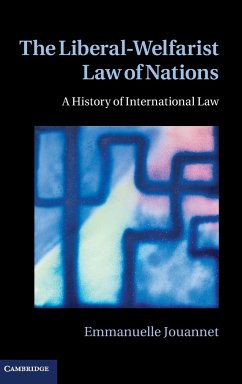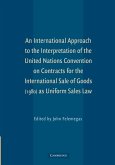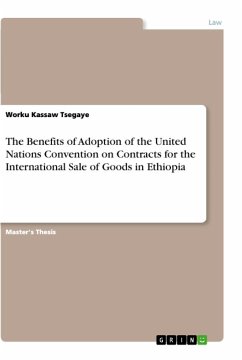- Gebundenes Buch
- Merkliste
- Auf die Merkliste
- Bewerten Bewerten
- Teilen
- Produkt teilen
- Produkterinnerung
- Produkterinnerung
Emmanuelle Jouannet explores the concept of international law from the European Enlightenment to the post-Cold War world.
Andere Kunden interessierten sich auch für
![The Intellectual Property of Nations The Intellectual Property of Nations]() Laura R. FordThe Intellectual Property of Nations102,99 €
Laura R. FordThe Intellectual Property of Nations102,99 €![An International Approach to the Interpretation of the United Nations Convention on Contracts for the International Sale of Goods (1980) as Uniform S An International Approach to the Interpretation of the United Nations Convention on Contracts for the International Sale of Goods (1980) as Uniform S]() An International Approach to the Interpretation of the United Nations Convention on Contracts for the International Sale of Goods (1980) as Uniform S45,99 €
An International Approach to the Interpretation of the United Nations Convention on Contracts for the International Sale of Goods (1980) as Uniform S45,99 €![ASEAN Law in the New Regional Economic Order ASEAN Law in the New Regional Economic Order]() ASEAN Law in the New Regional Economic Order152,99 €
ASEAN Law in the New Regional Economic Order152,99 €![The Benefits of Adoption of the United Nations Convention on Contracts for the International Sale of Goods in Ethiopia The Benefits of Adoption of the United Nations Convention on Contracts for the International Sale of Goods in Ethiopia]() Worku Kassaw TsegayeThe Benefits of Adoption of the United Nations Convention on Contracts for the International Sale of Goods in Ethiopia47,95 €
Worku Kassaw TsegayeThe Benefits of Adoption of the United Nations Convention on Contracts for the International Sale of Goods in Ethiopia47,95 €![Constitutional Change through Euro-Crisis Law Constitutional Change through Euro-Crisis Law]() Constitutional Change through Euro-Crisis Law94,99 €
Constitutional Change through Euro-Crisis Law94,99 €![The Cambridge Handbook of Disaster Law and Policy The Cambridge Handbook of Disaster Law and Policy]() The Cambridge Handbook of Disaster Law and Policy198,99 €
The Cambridge Handbook of Disaster Law and Policy198,99 €![The Cambridge Handbook of Technological Disruption in Labour and Employment Law The Cambridge Handbook of Technological Disruption in Labour and Employment Law]() The Cambridge Handbook of Technological Disruption in Labour and Employment Law209,99 €
The Cambridge Handbook of Technological Disruption in Labour and Employment Law209,99 €-
-
-
Emmanuelle Jouannet explores the concept of international law from the European Enlightenment to the post-Cold War world.
Hinweis: Dieser Artikel kann nur an eine deutsche Lieferadresse ausgeliefert werden.
Hinweis: Dieser Artikel kann nur an eine deutsche Lieferadresse ausgeliefert werden.
Produktdetails
- Produktdetails
- Verlag: Cambridge University Press
- Seitenzahl: 326
- Erscheinungstermin: 19. März 2012
- Englisch
- Abmessung: 235mm x 157mm x 22mm
- Gewicht: 629g
- ISBN-13: 9781107018945
- ISBN-10: 1107018943
- Artikelnr.: 34385608
- Herstellerkennzeichnung
- Libri GmbH
- Europaallee 1
- 36244 Bad Hersfeld
- gpsr@libri.de
- Verlag: Cambridge University Press
- Seitenzahl: 326
- Erscheinungstermin: 19. März 2012
- Englisch
- Abmessung: 235mm x 157mm x 22mm
- Gewicht: 629g
- ISBN-13: 9781107018945
- ISBN-10: 1107018943
- Artikelnr.: 34385608
- Herstellerkennzeichnung
- Libri GmbH
- Europaallee 1
- 36244 Bad Hersfeld
- gpsr@libri.de
Emmanuelle Jouannet is a Professor of International Law at the Sorbonne, where she currently directs the interdisciplinary programme 'International Law and Justice in a Global World'.
Introduction; Part I. The Modern Law of Nations: 1. The law of nations of
the Moderns: a new discipline; 2. The liberal purpose of the modern law of
nations: liberty, equality and security for states; 3. State interests and
self-esteem; 4. The modern law of nations between free-enterprise and
protectionism; 5. The welfarist purpose of the modern law of nations: the
happiness of the people and the advancement of states; 6. Cooperation and
assistance to states between liberalism and welfarism; 7. The
liberal-welfarist law of nations: a code of good conduct to discipline
European states; 8. Goodness, freedom and justice; Conclusion; Part II.
Classical International Law: 9. A modern commentator turned classical: the
Vattelian moment; 10. The triumph of the liberal purpose of international
law; 11. Liberal international law outflanked. A welfarist purpose for the
rest of the world; 12. Intellectual and political explanations and
justifications for the change; 13. Classical international law in the age
of free-enterprise: between free-trade and protectionism; 14. Liberal
vision, dogmatic foundation and the appeal of liberalism; 15. Concerns
about social and economic inequality. The emergence of a new welfarist
purpose; 16. The emergence of concerns for human rights; Conclusion; Part
III. Contemporary International Law: 17. Continuities and discontinuities
of the classical model; 18. The two liberal purposes of contemporary
international law; 19. The dilemmas of the new liberal purpose (I):
democracy, human rights and the rule of law; 20. The dilemmas of the new
liberal purpose (II): humanitarian interventions, identities and cultures;
21. The status report and general prospects for the new liberal and
democratic purpose; 22. The economic liberalism of contemporary
international law: between Keynesian objectives and the triumph of free
trade; 23. The general advancement of the welfarist purpose:
characteristics and difficulties; 24. The specific advancement of the
welfarist purpose: Third World(s) and development; Conclusion.
the Moderns: a new discipline; 2. The liberal purpose of the modern law of
nations: liberty, equality and security for states; 3. State interests and
self-esteem; 4. The modern law of nations between free-enterprise and
protectionism; 5. The welfarist purpose of the modern law of nations: the
happiness of the people and the advancement of states; 6. Cooperation and
assistance to states between liberalism and welfarism; 7. The
liberal-welfarist law of nations: a code of good conduct to discipline
European states; 8. Goodness, freedom and justice; Conclusion; Part II.
Classical International Law: 9. A modern commentator turned classical: the
Vattelian moment; 10. The triumph of the liberal purpose of international
law; 11. Liberal international law outflanked. A welfarist purpose for the
rest of the world; 12. Intellectual and political explanations and
justifications for the change; 13. Classical international law in the age
of free-enterprise: between free-trade and protectionism; 14. Liberal
vision, dogmatic foundation and the appeal of liberalism; 15. Concerns
about social and economic inequality. The emergence of a new welfarist
purpose; 16. The emergence of concerns for human rights; Conclusion; Part
III. Contemporary International Law: 17. Continuities and discontinuities
of the classical model; 18. The two liberal purposes of contemporary
international law; 19. The dilemmas of the new liberal purpose (I):
democracy, human rights and the rule of law; 20. The dilemmas of the new
liberal purpose (II): humanitarian interventions, identities and cultures;
21. The status report and general prospects for the new liberal and
democratic purpose; 22. The economic liberalism of contemporary
international law: between Keynesian objectives and the triumph of free
trade; 23. The general advancement of the welfarist purpose:
characteristics and difficulties; 24. The specific advancement of the
welfarist purpose: Third World(s) and development; Conclusion.
Introduction; Part I. The Modern Law of Nations: 1. The law of nations of
the Moderns: a new discipline; 2. The liberal purpose of the modern law of
nations: liberty, equality and security for states; 3. State interests and
self-esteem; 4. The modern law of nations between free-enterprise and
protectionism; 5. The welfarist purpose of the modern law of nations: the
happiness of the people and the advancement of states; 6. Cooperation and
assistance to states between liberalism and welfarism; 7. The
liberal-welfarist law of nations: a code of good conduct to discipline
European states; 8. Goodness, freedom and justice; Conclusion; Part II.
Classical International Law: 9. A modern commentator turned classical: the
Vattelian moment; 10. The triumph of the liberal purpose of international
law; 11. Liberal international law outflanked. A welfarist purpose for the
rest of the world; 12. Intellectual and political explanations and
justifications for the change; 13. Classical international law in the age
of free-enterprise: between free-trade and protectionism; 14. Liberal
vision, dogmatic foundation and the appeal of liberalism; 15. Concerns
about social and economic inequality. The emergence of a new welfarist
purpose; 16. The emergence of concerns for human rights; Conclusion; Part
III. Contemporary International Law: 17. Continuities and discontinuities
of the classical model; 18. The two liberal purposes of contemporary
international law; 19. The dilemmas of the new liberal purpose (I):
democracy, human rights and the rule of law; 20. The dilemmas of the new
liberal purpose (II): humanitarian interventions, identities and cultures;
21. The status report and general prospects for the new liberal and
democratic purpose; 22. The economic liberalism of contemporary
international law: between Keynesian objectives and the triumph of free
trade; 23. The general advancement of the welfarist purpose:
characteristics and difficulties; 24. The specific advancement of the
welfarist purpose: Third World(s) and development; Conclusion.
the Moderns: a new discipline; 2. The liberal purpose of the modern law of
nations: liberty, equality and security for states; 3. State interests and
self-esteem; 4. The modern law of nations between free-enterprise and
protectionism; 5. The welfarist purpose of the modern law of nations: the
happiness of the people and the advancement of states; 6. Cooperation and
assistance to states between liberalism and welfarism; 7. The
liberal-welfarist law of nations: a code of good conduct to discipline
European states; 8. Goodness, freedom and justice; Conclusion; Part II.
Classical International Law: 9. A modern commentator turned classical: the
Vattelian moment; 10. The triumph of the liberal purpose of international
law; 11. Liberal international law outflanked. A welfarist purpose for the
rest of the world; 12. Intellectual and political explanations and
justifications for the change; 13. Classical international law in the age
of free-enterprise: between free-trade and protectionism; 14. Liberal
vision, dogmatic foundation and the appeal of liberalism; 15. Concerns
about social and economic inequality. The emergence of a new welfarist
purpose; 16. The emergence of concerns for human rights; Conclusion; Part
III. Contemporary International Law: 17. Continuities and discontinuities
of the classical model; 18. The two liberal purposes of contemporary
international law; 19. The dilemmas of the new liberal purpose (I):
democracy, human rights and the rule of law; 20. The dilemmas of the new
liberal purpose (II): humanitarian interventions, identities and cultures;
21. The status report and general prospects for the new liberal and
democratic purpose; 22. The economic liberalism of contemporary
international law: between Keynesian objectives and the triumph of free
trade; 23. The general advancement of the welfarist purpose:
characteristics and difficulties; 24. The specific advancement of the
welfarist purpose: Third World(s) and development; Conclusion.








